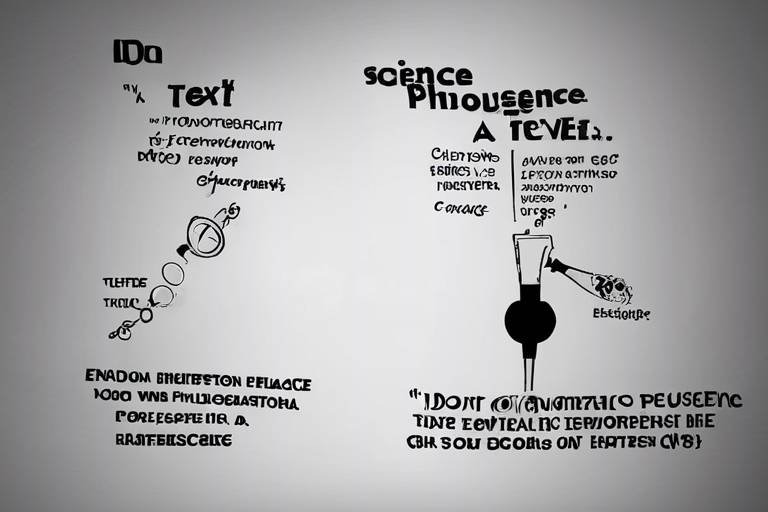Philosophy and Rhetoric in Clinical Research
Clinical research is the backbone of modern medicine, driving innovations that save lives and improve patient care. But have you ever wondered what underlies the methodologies and ethical frameworks that guide this research? Enter the dynamic duo of philosophy and rhetoric. These two fields might seem distant from the sterile labs and clinical trials, yet they are intricately woven into the fabric of clinical research. Philosophy offers the foundational principles that guide ethical decision-making and research integrity, while rhetoric shapes how these findings are communicated to the public, stakeholders, and policymakers.
Imagine philosophy as the compass that directs researchers toward ethical practices, ensuring that studies are not only scientifically sound but also morally upright. It prompts critical questions: What is the purpose of this research? Who benefits, and at what cost? On the other hand, rhetoric is the art of persuasion—it’s the flair with which researchers present their findings, making complex information accessible and engaging. The way researchers frame their studies can dramatically influence public perception and policy decisions.
The interplay between these two disciplines is crucial. For instance, consider a clinical trial for a new drug. The philosophical underpinnings guide the researchers to prioritize patient safety and informed consent. However, without effective rhetorical strategies, the significance of the findings may be lost on policymakers or the general public. This is where the fusion of philosophy and rhetoric becomes not just beneficial but essential for the progress of clinical research.
As we delve deeper into this topic, we will explore how philosophical principles inform ethical considerations in research, the role of rhetoric in scientific communication, and the implications of these elements on patient care and informed consent. By understanding this interplay, we can appreciate the complexity of clinical research and the importance of maintaining both ethical integrity and effective communication.
Philosophy serves as the bedrock of clinical research, offering a framework that guides researchers in making ethical decisions. It pushes us to think critically about the implications of our work. For example, when designing a clinical trial, researchers must grapple with questions of beneficence (doing good), non-maleficence (avoiding harm), autonomy (respecting patient choices), and justice (fair distribution of benefits and burdens). These ethical principles are not just theoretical; they have real-world implications for how studies are conducted and how patients are treated.
Moreover, philosophy encourages transparency and integrity in research practices. The ethical guidelines derived from philosophical inquiry help in maintaining trust between researchers and participants. This trust is vital, especially in clinical trials where participants often place their lives in the hands of researchers. By adhering to philosophical principles, researchers can ensure that their work is not only scientifically valid but also ethically sound, fostering a culture of accountability and respect in clinical research.
Now, let’s shift gears and talk about rhetoric—the art of persuasion that can make or break a research study’s impact. In clinical research, how findings are presented can significantly influence their reception among different audiences. A well-crafted narrative can transform dry data into a compelling story that resonates with stakeholders, policymakers, and the public. Rhetoric is not just about fancy words; it’s about clarity, context, and connection.
For instance, consider how a researcher presents the results of a clinical trial. If they simply state the statistics, they risk losing the audience's attention. However, if they weave those statistics into a narrative that highlights patient stories and real-world implications, they create an emotional connection that can drive action. This is the power of rhetoric in scientific communication—it shapes perceptions, influences decisions, and ultimately impacts patient care.
When it comes to crafting research proposals, effective persuasion techniques are essential. Researchers must not only present their ideas clearly but also convince funding bodies of their significance. This involves using rhetorical strategies such as:
- Appealing to emotions: Sharing patient experiences can evoke empathy and support.
- Establishing credibility: Citing previous successful studies can bolster a proposal's legitimacy.
- Highlighting urgency: Emphasizing the immediate need for research can prompt quicker funding decisions.
These strategies are crucial for garnering support and funding, underscoring the importance of rhetorical skills in the realm of clinical research.
While persuasion is essential, it’s equally important to consider the ethical implications of these techniques. Researchers must ensure that their persuasive tactics do not mislead or manipulate stakeholders. Transparency and honesty should always be at the forefront of communication. After all, the integrity of clinical research hinges on maintaining ethical standards while effectively conveying the importance of the work being done.
Analyzing successful research proposals can provide valuable insights into effective rhetorical strategies. For example, a proposal that successfully secured funding might have included:
- A clear statement of the research problem
- A well-defined methodology
- A compelling narrative that connected the research to real-world implications
These elements not only showcase the philosophical underpinnings of the research but also highlight the importance of engaging rhetoric in garnering support and driving progress in clinical research.
Evidence-based practice is rooted in philosophical inquiry, emphasizing the importance of critical thinking and sound reasoning in clinical decision-making. This approach encourages practitioners to integrate the best available evidence with clinical expertise and patient values, creating a holistic approach to patient care. The philosophical foundations of evidence-based practice ensure that decisions are not made lightly but are backed by rigorous research and ethical considerations.
The way information is communicated to patients during the informed consent process can significantly influence their understanding and autonomy. Rhetorical clarity is paramount in this context, as patients must grasp the risks, benefits, and alternatives to participating in a clinical trial. A well-structured conversation can empower patients, making them active participants in their healthcare decisions rather than passive recipients of information.
Implementing strategies that enhance clarity and understanding can improve patient engagement and decision-making in clinical research contexts. For instance, using plain language, visual aids, and interactive discussions can help demystify complex information, making it more accessible to patients. This not only fosters trust but also ensures that patients are making informed choices about their participation in research.
However, challenges remain in communicating complex information to patients. Factors such as health literacy, cultural differences, and emotional stress can hinder understanding. Identifying and addressing these challenges is essential for ethical clinical research practices. Researchers must strive to create an environment where patients feel comfortable asking questions and expressing concerns, ensuring that informed consent is not merely a formality but a meaningful dialogue.
- What is the role of philosophy in clinical research? Philosophy provides ethical guidelines and principles that shape research integrity and decision-making.
- How does rhetoric influence clinical research? Rhetoric shapes how research findings are communicated, impacting public perception and policy decisions.
- Why is informed consent important? Informed consent ensures that patients understand the risks and benefits of participating in research, promoting autonomy and trust.
- What are effective strategies for communicating with patients? Using plain language, visual aids, and fostering open dialogue can enhance patient understanding and engagement.

The Role of Philosophy in Clinical Research
Philosophy serves as the backbone of clinical research, providing essential frameworks that guide ethical decision-making and ensure research integrity. When researchers embark on a clinical study, they are not merely conducting experiments; they are navigating a complex landscape of moral and ethical considerations that can significantly impact the lives of individuals. Imagine philosophy as a compass, directing researchers towards ethical practices and sound reasoning. It encourages them to ask critical questions, such as: What is the purpose of this research? Who benefits from it? Are we respecting the autonomy and dignity of participants?
At its core, philosophy in clinical research is about understanding the principles of ethics, epistemology, and ontology. These principles help researchers to formulate hypotheses that are not only scientifically valid but also ethically sound. For instance, the ethical principle of respect for persons emphasizes the importance of informed consent, ensuring that participants understand what they are signing up for. This principle is crucial in building trust between researchers and participants, ultimately leading to better research outcomes.
Moreover, philosophical inquiry encourages researchers to critically evaluate their methodologies. This means questioning whether the chosen methods are the most appropriate for answering the research question at hand. Are we using the right tools to gather data? Are we interpreting the findings in a way that aligns with ethical standards? Such questions are vital for maintaining the integrity of the research process.
In addition, philosophy sheds light on the importance of transparency in clinical research. Researchers are encouraged to disclose potential conflicts of interest and funding sources, which can influence the research outcomes. By being transparent, researchers not only uphold the ethical standards of their field but also enhance the credibility of their findings. This transparency fosters a culture of accountability, where researchers are held to the highest ethical standards.
To illustrate the role of philosophy in clinical research, consider the following table that outlines key philosophical principles and their implications for research practices:
| Philosophical Principle | Implication for Clinical Research |
|---|---|
| Respect for Persons | Ensures informed consent and participant autonomy. |
| Beneficence | Promotes actions that benefit participants and minimize harm. |
| Justice | Ensures equitable distribution of research benefits and burdens. |
| Integrity | Promotes honesty and transparency in research reporting. |
In summary, the interplay of philosophical principles in clinical research is not just an academic exercise; it is a vital component that shapes the ethics, integrity, and outcomes of research endeavors. By embracing these philosophical foundations, researchers can navigate the complexities of clinical research with a sense of purpose and responsibility, ensuring that their work contributes positively to the field of medicine and the lives of individuals. Ultimately, philosophy enriches clinical research, making it a more profound and ethically sound pursuit.

Understanding Rhetoric in Scientific Communication
When it comes to clinical research, the way we communicate our findings can be just as crucial as the findings themselves. Rhetoric is not just about fancy words or persuasive speeches; it's about the art of effective communication that can shape perceptions and influence decisions. Imagine a scenario where a groundbreaking study reveals a new treatment for a chronic disease. If the research is presented in a confusing manner, its significance could be lost on policymakers, practitioners, and even patients. Therefore, mastering the nuances of rhetoric is essential in ensuring that scientific communication is not only clear but also impactful.
At its core, rhetoric involves understanding your audience and tailoring your message to resonate with them. This means considering their values, beliefs, and even their emotional responses. For example, when researchers present findings to a group of clinicians, they might emphasize data and statistics to appeal to their analytical mindset. Conversely, when speaking to patients, the focus may shift to personal stories and outcomes that evoke empathy and understanding. The goal is to bridge the gap between complex scientific data and the real-world implications that affect everyday lives.
Moreover, the structure of communication plays a pivotal role in rhetoric. A well-organized presentation or paper can guide the audience through the research journey, highlighting key points while minimizing confusion. This is where the classic rhetorical triangle—comprising ethos (credibility), pathos (emotional appeal), and logos (logical argument)—comes into play. Each component is vital in constructing a compelling narrative that not only informs but also persuades. For instance:
| Element | Description | Example |
|---|---|---|
| Ethos | The credibility of the speaker or researcher. | A well-respected researcher presenting findings. |
| Pathos | Emotional appeal to the audience. | Sharing a patient’s story to highlight the impact of a treatment. |
| Logos | Logical reasoning and evidence. | Presenting statistical data to support claims. |
In addition to these elements, the choice of language and tone can significantly affect the reception of scientific communication. Using jargon might alienate non-expert audiences, while overly simplistic language could undermine the complexity of the research. Striking the right balance is key. This is where the skill of a good communicator shines—being able to distill complex ideas into digestible formats without losing their essence.
Furthermore, visual aids such as graphs, charts, and infographics can enhance rhetorical effectiveness. These tools not only break down complex data but also facilitate quicker understanding among diverse audiences. A well-placed visual can serve as a powerful rhetorical device, reinforcing the spoken or written word and making the research more accessible.
Ultimately, the impact of rhetoric in scientific communication cannot be overstated. It shapes how research is perceived and can influence policy decisions, funding opportunities, and patient care practices. As we navigate the ever-evolving landscape of clinical research, understanding and employing effective rhetorical strategies will be crucial in ensuring that our findings resonate and lead to meaningful change.
- What is the importance of rhetoric in clinical research?
Rhetoric is essential in clinical research as it helps in effectively communicating findings, influencing policy decisions, and improving patient understanding. - How can researchers improve their rhetorical skills?
Researchers can enhance their rhetorical skills by practicing clear and concise communication, understanding their audience, and using visual aids to support their messages. - What role does emotional appeal play in scientific communication?
Emotional appeal (pathos) can help connect with the audience on a personal level, making the research more relatable and impactful.

Persuasion Techniques in Research Proposals
When it comes to crafting a compelling research proposal, persuasion techniques are not just optional; they are essential. Think of your proposal as a story waiting to be told, where every word has the power to captivate your audience and sway their decision. The goal is to not only present your research idea but to ignite enthusiasm and secure funding. So, how do you achieve this? Let’s dive into some effective strategies that can make your proposal stand out.
First off, it's crucial to establish a strong emotional connection with your audience. This means you should start by clearly articulating the problem your research aims to solve. Use vivid language and relatable examples to paint a picture of the issue at hand. For instance, if your research addresses a health crisis, share a compelling anecdote that highlights the human impact of this crisis. This approach not only grabs attention but also invokes empathy, making your audience more likely to support your proposal.
Next, consider the use of rhetorical questions. These are powerful tools that can provoke thought and engage your readers. Posing questions like, “What if we could reduce the incidence of this disease by 50%?” encourages your audience to visualize the potential impact of your research. It subtly nudges them to consider the significance of your work and fosters a sense of urgency.
Another effective technique is to incorporate data and statistics to bolster your claims. Numbers can be incredibly persuasive when used correctly. For example, you might say, “According to recent studies, 1 in 5 individuals suffer from this condition, yet funding for research has remained stagnant.” Presenting hard facts not only adds credibility to your proposal but also emphasizes the need for action.
Moreover, you should clearly outline the benefits of your research. This is where you can highlight how your study will contribute to existing knowledge, influence policy, or improve patient outcomes. Make sure to articulate the long-term implications of your work. A well-structured benefits section can be the difference between a proposal that gets funded and one that gets tossed aside.
Lastly, don't underestimate the power of a strong conclusion. This is your final chance to persuade your audience, so make it count! Summarize the key points of your proposal and reinforce the importance of your research. A call to action, such as inviting stakeholders to join you in this endeavor, can leave a lasting impression and encourage further discussion.
In summary, effective persuasion techniques in research proposals are about more than just presenting facts; they are about weaving a narrative that resonates with your audience. By fostering emotional connections, utilizing rhetorical questions, backing your claims with data, outlining benefits, and crafting a strong conclusion, you can significantly enhance the persuasive power of your proposal. Remember, the goal is to inspire action and enthusiasm for your research.
- What are the key components of a persuasive research proposal?
A persuasive research proposal typically includes a clear problem statement, a compelling narrative, supporting data, outlined benefits, and a strong conclusion.
- How can I improve my writing style for proposals?
To improve your writing style, focus on clarity, use active voice, and engage your audience with relatable examples and vivid language.
- Why is emotional appeal important in research proposals?
Emotional appeal helps to create a connection with the audience, making them more likely to support your research and see its significance.

Ethical Considerations in Persuasion
When it comes to clinical research, persuasion is not just about convincing others; it's about doing so with integrity and transparency. The ethical landscape surrounding persuasive tactics in research proposals is complex, and navigating it requires a deep understanding of both philosophical principles and the responsibilities researchers hold towards their participants and stakeholders. After all, the stakes are high—research outcomes can influence medical practice, policy decisions, and ultimately, patient health.
One of the primary ethical considerations is the honesty of the information presented. Researchers must ensure that their proposals do not exaggerate potential benefits or downplay risks. Misleading information can lead to poor decision-making, not only among funding bodies but also among patients who might be affected by the research. Therefore, it is crucial to strike a balance between persuasive communication and truthfulness.
Moreover, ethical persuasion in clinical research should respect the autonomy of all stakeholders involved. This means that while researchers aim to garner support for their studies, they must also provide complete and unbiased information, allowing stakeholders to make informed decisions. For instance, when drafting a proposal, researchers should consider the following:
- Are all potential risks clearly outlined?
- Is the language used accessible to non-experts?
- Have the implications of the research been thoroughly discussed?
In addition to transparency, researchers need to reflect on the power dynamics at play. When persuading funding bodies or institutional review boards, researchers often hold a position of authority. This can create an ethical dilemma where the persuasive tactics employed may unintentionally undermine the voices of those who are affected by the research, particularly vulnerable populations. It's essential to recognize this imbalance and strive for an inclusive approach that seeks input from diverse groups.
Furthermore, ethical considerations should also encompass the long-term impacts of the research. It’s not enough to simply secure funding; researchers must think critically about how their work will be perceived and utilized in the real world. Are they contributing to a body of knowledge that genuinely benefits society, or are they merely chasing grants with little regard for the broader implications? The answer to this question lies in the philosophical underpinnings of their research approach.
Ultimately, ethical persuasion in clinical research is about more than just getting a proposal approved. It’s about fostering a culture of responsibility and respect for all involved. By adhering to ethical standards in persuasive communication, researchers can not only enhance the credibility of their work but also contribute positively to the field of clinical research as a whole.
- What are the key ethical principles in clinical research? The key principles include respect for persons, beneficence, and justice, which guide researchers in their ethical obligations.
- How can researchers ensure transparency in their proposals? Researchers can ensure transparency by providing clear, concise, and comprehensive information about their study's purpose, methodology, and potential risks.
- What role does language play in ethical persuasion? Language is crucial; it should be accessible and devoid of jargon to ensure that all stakeholders understand the research implications.
- How can power dynamics affect ethical persuasion? Power dynamics can lead to imbalances in communication, where the voices of vulnerable populations may be overlooked, necessitating a more inclusive approach.

Case Studies of Successful Proposals
When we dive into the world of clinical research, the importance of well-crafted proposals cannot be overstated. Successful proposals often serve as the backbone of groundbreaking studies, showcasing not only the necessity of research but also the philosophical and rhetorical finesse that underpins them. One of the most compelling case studies is the Framingham Heart Study, which has been pivotal in understanding cardiovascular diseases. The proposal for this long-term study was crafted with a clear vision, emphasizing the need for longitudinal data to identify risk factors. By effectively communicating the urgency of the research, the proposal garnered the necessary funding and support from both governmental and private entities.
Another notable example is the Women’s Health Initiative, which aimed to address the health issues facing postmenopausal women. The proposal's strength lay in its ability to resonate with stakeholders by highlighting the ethical implications of neglecting women's health in clinical research. The researchers employed a blend of statistical evidence and poignant narratives, which not only appealed to emotions but also established a solid ethical framework for the study. This case illustrates how a proposal that integrates philosophical inquiry with persuasive rhetoric can lead to significant advancements in health research.
In analyzing these successful proposals, we can identify several key rhetorical strategies that contributed to their effectiveness:
- Clear Objectives: Each proposal articulated specific, measurable goals that aligned with broader health initiatives.
- Stakeholder Engagement: The proposals actively involved stakeholders from the outset, ensuring their needs and concerns were addressed.
- Ethical Considerations: Both proposals emphasized ethical research practices, which not only built trust but also demonstrated a commitment to integrity.
Moreover, these case studies highlight the significance of a well-structured argument. The use of data, combined with compelling narratives, creates a persuasive narrative that resonates with funding bodies and the scientific community alike. The successful proposals also exemplified the need for transparency in methodology and anticipated outcomes, which is crucial for gaining trust and support.
In conclusion, the intersection of philosophy and rhetoric in these case studies reveals that successful research proposals are not merely documents; they are strategic narratives that reflect deep ethical considerations and persuasive techniques. By learning from these examples, future researchers can enhance their proposal-writing skills, ensuring that their innovative ideas receive the attention and funding they deserve.
Q1: What is the importance of rhetoric in clinical research proposals?
A1: Rhetoric is crucial in clinical research proposals as it helps convey the significance and urgency of the research, persuades stakeholders, and ensures the proposal stands out in a competitive funding landscape.
Q2: How can ethical considerations be integrated into research proposals?
A2: Ethical considerations can be integrated by clearly outlining the ethical implications of the research, ensuring participant safety, and demonstrating a commitment to transparency and integrity throughout the research process.
Q3: What are some common strategies for crafting successful research proposals?
A3: Common strategies include setting clear objectives, engaging stakeholders early, employing persuasive narratives, and emphasizing ethical practices to build trust and credibility.

Philosophical Foundations of Evidence-Based Practice
The concept of evidence-based practice (EBP) is not just a buzzword in clinical research; it is deeply rooted in philosophical inquiry. At its core, EBP emphasizes the necessity of integrating the best available research evidence with clinical expertise and patient values. This intersection is where philosophy comes into play, providing the foundational principles that guide decision-making in healthcare.
One of the primary philosophical underpinnings of EBP is empiricism, which posits that knowledge is primarily derived from sensory experience. In the context of clinical research, this means that practitioners should rely on data collected through rigorous studies and trials. However, it’s essential to recognize that not all data is created equal. The philosophical debate surrounding epistemology—the study of knowledge—raises questions about what constitutes valid and reliable evidence. This scrutiny is crucial as it influences how we interpret research findings and apply them in real-world settings.
Additionally, the principle of pragmatism plays a significant role in EBP. Pragmatism suggests that the truth of a belief is determined by its practical outcomes. In clinical settings, this means that the effectiveness of a treatment should be evaluated based on its results in improving patient health and quality of life. This philosophical approach encourages clinicians to be flexible and adaptive, integrating new evidence as it becomes available and adjusting their practices accordingly.
Furthermore, the ethical dimension of EBP cannot be overlooked. Utilitarianism, a philosophical theory that advocates for actions that maximize happiness and well-being, is particularly relevant here. In clinical research, ethical considerations must guide the implementation of evidence-based practices to ensure that they benefit the greatest number of patients while minimizing harm. This ethical lens helps clinicians navigate complex decisions where evidence may be ambiguous or conflicting.
To sum up, the philosophical foundations of evidence-based practice are multi-faceted, encompassing empiricism, pragmatism, and ethical considerations. These principles not only shape how research is conducted and interpreted but also influence how clinicians apply this knowledge in practice. By grounding their decisions in a solid philosophical framework, healthcare professionals can enhance the quality of care they provide, ultimately leading to better patient outcomes.
- What is evidence-based practice? Evidence-based practice is the integration of the best available research evidence with clinical expertise and patient values to guide healthcare decisions.
- Why is philosophy important in evidence-based practice? Philosophy provides the foundational principles that guide ethical decision-making, the interpretation of evidence, and the application of research findings in clinical settings.
- How does utilitarianism relate to evidence-based practice? Utilitarianism emphasizes actions that maximize well-being, which is crucial in ensuring that evidence-based practices benefit the majority of patients while minimizing harm.

Impact of Rhetoric on Patient Informed Consent
The informed consent process is a pivotal moment in clinical research, where the balance of power shifts towards the patient. It’s not just about signing a document; it's about understanding the implications of participation in a study. Here, rhetoric plays a critical role. The way information is communicated can significantly influence a patient's comprehension and autonomy. Imagine being presented with a complex medical study—if the explanation is convoluted or filled with jargon, how can a patient make an informed choice? This is where the art of rhetoric comes into play, transforming dense information into digestible insights.
Effective rhetoric in informed consent involves clarity, empathy, and persuasion. Researchers must not only convey the necessary information but also connect with patients on a personal level. For instance, using relatable analogies can help demystify technical terms. If a researcher compares a clinical trial to a journey, it becomes easier for patients to visualize their role and the potential outcomes. This kind of rhetorical strategy enhances understanding and fosters trust, which is essential for ethical clinical practices.
Furthermore, rhetorical clarity is not just about simplifying language; it also encompasses the structure of the information presented. A well-organized consent form, with headings and bullet points, can guide patients through the critical aspects of the study. Consider the following key elements that should be included in any informed consent process:
- Purpose of the Study: Clearly explain why the research is being conducted.
- Procedures Involved: Outline what participation entails, including any risks.
- Potential Benefits: Discuss what the patient might gain from participating.
- Confidentiality: Assure patients about the security of their personal information.
Moreover, the tone of the communication also matters. A warm, inviting approach can make patients feel more comfortable and valued. This is particularly important in sensitive areas of research, such as oncology or mental health, where the stakes are incredibly high. When patients feel respected and understood, they are more likely to engage fully in the consent process and make informed decisions.
However, challenges persist in achieving effective communication. One of the primary hurdles is the varying levels of health literacy among patients. Not everyone has the same understanding of medical terminology or research processes. Therefore, researchers must adapt their rhetorical strategies to meet diverse needs. This might involve using visual aids, such as charts or infographics, to complement verbal explanations.
In conclusion, the impact of rhetoric on patient informed consent cannot be overstated. It shapes not only how information is presented but also how it is perceived. By employing clear, empathetic, and structured communication, researchers can enhance patient understanding and autonomy, ultimately leading to better ethical practices in clinical research.
1. Why is rhetoric important in informed consent?
Rhetoric is crucial because it influences how information is communicated and understood by patients, affecting their ability to make informed choices.
2. How can researchers improve their communication during the consent process?
Researchers can improve communication by using clear language, relatable analogies, and structured information, as well as being empathetic to patients' concerns.
3. What challenges do researchers face in informed consent communication?
Challenges include varying levels of health literacy among patients and the complexity of medical terminology, which can hinder understanding.

Strategies for Effective Communication
Effective communication in clinical research is not just a nice-to-have; it's a must-have. When it comes to conveying complex medical information to patients, the stakes are incredibly high. Imagine trying to explain a complicated clinical trial to someone who has no background in medicine—it's a bit like trying to teach a toddler how to drive a car! You need to break things down into bite-sized pieces that are easy to digest. So, how can we achieve this?
First and foremost, clarity is key. This means using simple language and avoiding jargon that can confuse patients. Instead of saying, "This study will evaluate the pharmacokinetics of the drug," try something like, "We want to see how the body processes this medication." This small shift can make a world of difference in understanding.
Another strategy involves active listening. It's not enough to just talk at patients; you need to engage them in a dialogue. Ask questions like, "What concerns do you have about this trial?" or "Do you feel comfortable with the information I've provided so far?" This not only makes patients feel valued but also allows researchers to gauge their understanding and adjust explanations accordingly.
Visual aids can also play a pivotal role in effective communication. Think about using charts, graphs, or even simple infographics that can help illustrate complex concepts. For example, a chart showing the potential benefits and risks of a treatment can provide a clear visual comparison that helps patients make informed decisions.
Moreover, repetition is a powerful tool. When discussing crucial information, repeating key points can reinforce understanding. For instance, when explaining the informed consent process, reiterate what it means, why it’s important, and what patients can expect. This not only aids memory retention but also builds trust, as patients feel more informed and less anxious.
Finally, consider the environment in which the information is communicated. A calm, private setting can significantly enhance the patient's ability to process information. If a patient feels rushed or distracted, they are less likely to absorb what is being said. Therefore, creating a conducive environment for communication is as important as the content being delivered.
To summarize, effective communication strategies in clinical research should include:
- Using clear and simple language
- Engaging in active listening
- Incorporating visual aids
- Reinforcing key points through repetition
- Creating a comfortable environment for discussions
By implementing these strategies, researchers can significantly enhance patient understanding and engagement, ultimately leading to better outcomes in clinical research.
Q: Why is effective communication important in clinical research?
A: Effective communication ensures that patients understand the research process, their rights, and the potential risks and benefits, leading to informed consent and better participation.
Q: What role does active listening play in communication?
A: Active listening helps researchers gauge patients' understanding and concerns, allowing for tailored explanations that enhance comprehension.
Q: How can visual aids improve patient understanding?
A: Visual aids simplify complex information, making it easier for patients to grasp important concepts and make informed decisions.
Q: What should be considered when choosing a communication environment?
A: A calm and private space minimizes distractions, allowing patients to focus on the information being shared.

Challenges in Informed Consent Communication
Informed consent is a cornerstone of clinical research, acting as a bridge between researchers and participants. However, the communication of this consent is fraught with challenges that can hinder understanding and, ultimately, ethical participation. One of the primary hurdles is the complexity of the information presented. Often, clinical research involves intricate medical terminology and statistical data that can leave participants feeling overwhelmed. Imagine trying to navigate a dense forest without a map; that’s how many patients feel when faced with the details of a study.
Another significant challenge is the varying levels of health literacy among participants. Not everyone has the same background knowledge or familiarity with medical concepts, which can lead to misunderstandings. For instance, a participant with limited medical knowledge might misinterpret the risks involved, thinking they are less severe than they truly are. This discrepancy can lead to a situation where a patient consents to participate without fully grasping the implications. To illustrate this, consider a table that summarizes the potential risks and benefits of participation in a clinical trial:
| Aspect | Potential Risks | Potential Benefits |
|---|---|---|
| Physical Health | Side effects, complications | Access to new treatments |
| Mental Well-being | Stress, anxiety over unknowns | Empowerment through participation |
| Time Commitment | Frequent visits, lengthy procedures | Contribution to medical knowledge |
Moreover, the emotional state of participants can greatly affect their comprehension. When individuals are anxious or distressed—perhaps due to a recent diagnosis—they may not fully absorb the information being conveyed. This emotional barrier can lead to a superficial understanding of what participation entails. Researchers must be aware of these emotional dynamics and strive to create an environment where patients feel comfortable asking questions and expressing concerns.
Additionally, cultural differences can play a role in how informed consent is perceived and understood. Different cultural backgrounds may influence how individuals interpret risk, authority, and the concept of consent itself. For instance, in some cultures, there may be a greater emphasis on family decision-making rather than individual autonomy, which can complicate the informed consent process. Researchers need to engage in cultural competency training to navigate these complexities effectively.
Finally, the timing of the consent process can also pose challenges. Often, consent is sought during a clinical encounter when patients are already feeling vulnerable or overwhelmed by their medical condition. This pressure can lead to hasty decisions without thorough understanding. It is crucial for researchers to allow ample time for discussion and reflection, ensuring that participants feel empowered to make informed decisions.
In summary, the challenges in informed consent communication are multifaceted, involving complexities of language, emotional states, cultural differences, and timing. To enhance the informed consent process, researchers should prioritize clear communication, actively engage with participants, and provide ample resources for understanding. Only then can we ensure that participants are truly informed and able to make decisions that align with their values and preferences.
- What is informed consent? Informed consent is the process by which participants are given comprehensive information about a clinical study, allowing them to make an educated decision about their participation.
- Why is informed consent important? It ensures that participants understand the risks and benefits of a study, promoting ethical standards in clinical research.
- What challenges do researchers face in obtaining informed consent? Challenges include complex information, varying health literacy, emotional states, cultural differences, and timing of the consent process.
- How can researchers improve informed consent communication? By simplifying language, allowing time for questions, and being culturally sensitive, researchers can enhance the informed consent process.
Frequently Asked Questions
- What is the role of philosophy in clinical research?
Philosophy serves as the backbone of clinical research by providing essential principles that guide ethical decision-making and uphold research integrity. It shapes how studies are designed, interpreted, and ultimately influences the outcomes of clinical trials.
- How does rhetoric impact scientific communication?
Rhetoric is crucial in scientific communication as it affects how research findings are presented and perceived. Effective rhetorical strategies can enhance the impact of clinical research on policy, practice, and public understanding.
- What are some effective persuasion techniques in research proposals?
Crafting compelling research proposals often relies on persuasive techniques such as storytelling, clear data presentation, and emotional appeal. These strategies help in garnering support and funding by resonating with stakeholders and decision-makers.
- Are there ethical considerations in using persuasive tactics?
Yes, while persuasive tactics are essential, it's crucial to maintain integrity and transparency. Ethical considerations involve ensuring that the information presented is accurate and does not mislead stakeholders, which is vital for maintaining trust in clinical research.
- How can philosophical foundations enhance evidence-based practice?
The philosophical foundations of evidence-based practice emphasize critical thinking and sound reasoning. By rooting clinical decision-making in philosophical inquiry, practitioners can better evaluate evidence and make informed choices that benefit patient care.
- What strategies can improve patient understanding during informed consent?
Strategies such as using plain language, visual aids, and interactive discussions can significantly enhance patient understanding during the informed consent process. These approaches help ensure that patients are fully informed and empowered to make decisions about their care.
- What challenges exist in communicating informed consent?
Challenges in informed consent communication can include complex medical jargon, varying health literacy levels among patients, and emotional responses to medical information. Addressing these challenges is essential for ethical clinical research practices and ensuring patient autonomy.



















